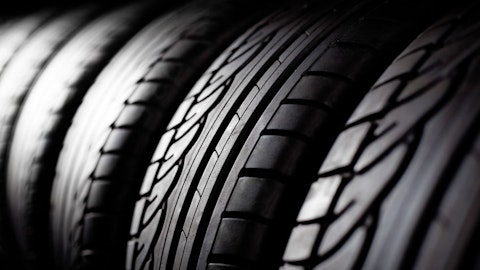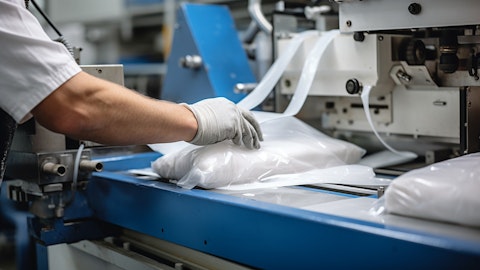David Begleiter: Very good. You mentioned this, again, $100 million cost improvement, including natural gas hedge losses in 2024. What’s the potential for that number to be higher than the $100 million you’ve forecasted?
Frank Bozich: Can you just repeat the question? What’s the potential for the savings associated with all the restructuring to be higher than $100 million? Is that the question.
David Begleiter: Correct. Yes.
David Stasse: Yeah, I’ll try and take a stab at that, Dave. Look, I think the largest contributor of that $100 million is obviously shutting down the styrene facilities. And I wanted to say this on this call, just — Dave, you’ve been following us since we’ve been public, and almost that entire duration since we’ve been public, a large part of our identity has been a styrene producer. So we’ve been long styrene. We’re the opposite now. We’re short styrene. We’re a buyer of styrene for our downstream businesses. So what would lead to that number being higher is a more depressed styrene market. So we’re no longer producing styrene. We’re buying it. If we were producing it now, we would have significant, significant losses, as are other European styrene producers now as we speak.
So I guess kind of in a perverse way a worsening environment would result in that $100 million being higher because we benefit from lower styrene pricing now. That may or may not have — that kind of environment would be apt to have maybe a negative environment elsewhere in the business. But look, I’m very comfortable on the $100 million number. As I said, if we were producing styrene right now, we would be generating — starting in Q1, we no longer have a feedstock segment. But if we did and we were producing, it would be significantly negative.
Frank Bozich: Yeah, I guess — maybe I — let me just add one thing. I said this in my prepared remarks. But we have additional opportunities that we continue to evaluate, that, we would expect if we implement those and move forward, that they would accrue in the latter part of the year. So again, we’re always looking. There are significant market opportunities to take advantage of, of inter-regional cost differences and change our supply chain and flex the network, and we will continue to evaluate those. So those could be additive to the $100 million also.
David Begleiter: Thank you.
Operator: We’ll take our next question from Matthew Blair at TPH.
Matthew Blair: Hey, good morning. I was wondering if there’s any update on the styrene sale process, the styrenic sale process? And is that something that could happen in 2024?
Frank Bozich: So we don’t really have an update. I would say there’s nothing imminent. We continue to field questions about and field interest on specific assets, but nothing’s imminent.
Matthew Blair: Okay. And then I was hoping you could help us just a little bit more with the bridge from the $20 million in Q4 to $40 million to $50 million in Q1. It sounds like some of the specialty volumes are picking up a little bit. Are you seeing margin improvement anywhere? And then also do you expect to roll off like any of the natural gas headwinds or net timing benefits into Q1?
Frank Bozich: Well, let me — there’s three things that are really driving — three elements that are driving the improvement from Q4 to Q1. And number one is volume. Number two is the full benefit of the restructuring activities. And the third thing I would say is we did have a turnaround in our EM business. Our biggest resin plant in Bristol had an extended turnaround in Q4. And that’s behind us now. So those are the drivers that would — as well as — volume, the restructuring benefit and the turnaround as it relates to — Dave can…
David Stasse: Yeah. Look Matthew, as it relates to the natural gas hedges, we had $9 million — it was a $9 million loss in Q4. It’s going to be about a $5 million loss in Q1. And for the full — look, I expect to not really be talking about that anymore. It was a significant number in ’23 for the full year. ’24, it’s going to be about $10 million. And as I said, $4 million or $5 million of that is going to be in Q1 and then it falls off. So there is a sequential pickup of $4 million there.
Matthew Blair: Great. Thank you very much.
Operator: We’ll go next to Hassan Ahmed at Alembic Global Advisors.
Hassan Ahmed: Good morning, Frank and Dave. Look, I obviously understand that you guys aren’t giving full year 2024 guidance with sort of all the uncertainties and macro issues and the like. But again, back in Q3, you guys were alluding to sort of somewhat of a bridge to 2024 in terms of all the controllables, right? And you alluded to the restructuring benefits, the benefits from the Terneuzen side of things, restructuring, let’s call it, $100 million. Net timing was another $16 million tailwind. Terneuzen was around $60 million. So call it $175 million of tailwinds. Now, if I tack that on to even the low point, call it annualized Q4 EBITDA of $80 million, I come up with a number which is $250 million to $260 million for 2024. But if I were to then get a little more aggressive, annualize your Q1 guidance, we’re well north of $300 million. How are you thinking about at least the floor for 2024 EBITDA?
Frank Bozich: Look — maybe let me start with what’s changed since Q3 and what we’re seeing in the markets, because I think you can’t — I wouldn’t — sitting here today I don’t think we can look at Q3 as a reference and build off of that. And the reason is that we’ve seen a significant margin deterioration in polycarbonate, ABS, and polystyrene. And what those chemistries all have in common is a significant overhang in capacity in China. And absent some market recovery in China, I don’t really expect to see margins at the Q3 levels in the near term. And I would say, frankly, this is very consistent with the views expressed by all of our industry peers. And I would just give you an anecdote. Look, I spent the last two weeks in Asia visiting clients across our value chains, and what I would tell you in general is that all of our Chinese customers are of a view that there will be no domestic growth in their business — or domestic demand growth in their business in 2024.
And the growth that they can expect and they’re planning for is due to exports into Europe, which is the highest cost region. So I think that’s what’s changed and why we’re reluctant at this point to provide any certainty about the full year 2024. There’s just too many moving parts in how China will develop and some of the other costs will develop. However, that being said, there are opportunities for us to continue flexing the network and to take advantage of regional cost arbitrage as well as reduce fixed costs. And that’s what we’re focused on, what’s in our control.


